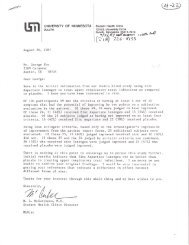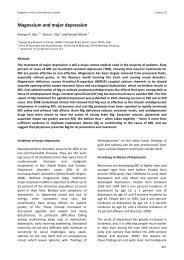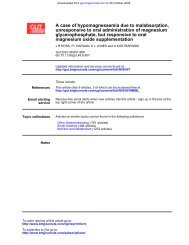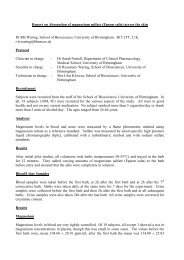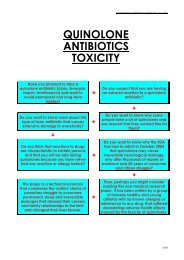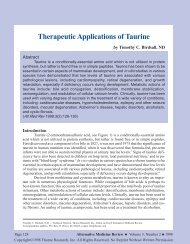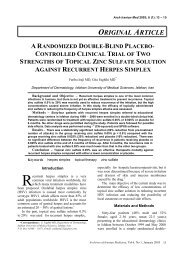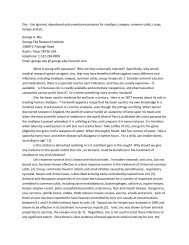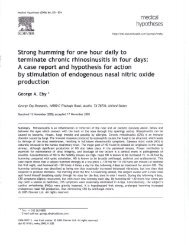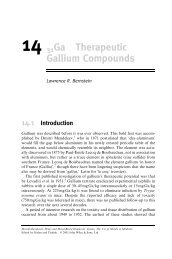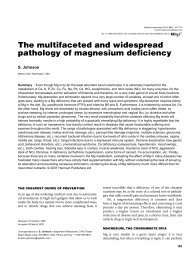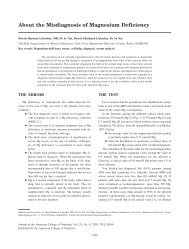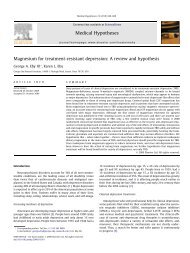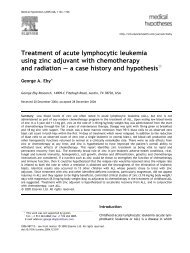Zinc Lozenges: Cold Cure or Candy? - Bioscience Reports
Zinc Lozenges: Cold Cure or Candy? - Bioscience Reports
Zinc Lozenges: Cold Cure or Candy? - Bioscience Reports
Create successful ePaper yourself
Turn your PDF publications into a flip-book with our unique Google optimized e-Paper software.
<strong>Zinc</strong> <strong>Lozenges</strong>: <strong>Cold</strong> <strong>Cure</strong> <strong>or</strong> <strong>Candy</strong>?<br />
31<br />
Using ZA lozenges, Petrus et al. [30] in 1998, found significant reductions in<br />
mean duration (3.8 days zinc, 5.1 days placebo, f<strong>or</strong> a 1.8 days difference p ¼ 0.008)<br />
and reductions in severity of common colds using 9 mg of zinc in 2.7-g dextrose based<br />
lozenges. <strong>Lozenges</strong> were used each 1.5 hr on the first day and every 2 hr on following<br />
days during wakeful hours (8 per day). <strong>Lozenges</strong> dissolved in about 15 min. Daily iZn<br />
was 72 mg. Petrus also found that ZA lozenges relieved nasal symptoms much faster<br />
in common cold patients with a hist<strong>or</strong>y of allergy, but without active allergy symptoms,<br />
compared with allergy-negative subjects (0.8 days vs. 4.1 days p < 0.04).<br />
Prasad et al. [12] in 2000, found meaningful and significant efficacy using<br />
12.8 mg zinc (ZA) in 4.0 g lozenges. <strong>Lozenges</strong> were used each 2–3 hr (6.25 per day)<br />
and they dissolved in about 30 min. iZn was 80 mg. Fifty percent of zinc recipients<br />
were well in 3.8 days and 50% of placebo recipients were well in 7.7 days (3.9 days<br />
difference). The zinc group had sh<strong>or</strong>ter mean durations of colds (4.5 vs. 8.1 days<br />
p < 0.01, a 3.6 day reduction), decreased total severity sc<strong>or</strong>es f<strong>or</strong> all symptoms with<br />
good placebo blinding, mild <strong>or</strong> no side effects and little difference in side effects<br />
compared with mild tasting placebo. The effect was sufficiently strong that Prasad<br />
suggested seeing a physician f<strong>or</strong> a bacterial infection if symptoms were not significantly<br />
improved after using ZA lozenges f<strong>or</strong> 3 days.<br />
The Petrus and Prasad compressed lozenges were designed by the present auth<strong>or</strong><br />
and were identical in composition. In addition to ZA, they contained directly<br />
compressible (agglomerated) dextrose as the tablet base, glycerol mono-sterate<br />
(2.5% tablet weight) as tablet lubricant, stevia f<strong>or</strong> added sweetness and peppermint<br />
oil f<strong>or</strong> flav<strong>or</strong>, with the composition compressed to near maximal hardness f<strong>or</strong> slowest<br />
dissolution. Those ingredients were chosen specifically because they do not react with<br />
iZn. The slower dissolution of the 4-g size lozenges was an advantage over the<br />
smaller lozenges in terms of efficacy.<br />
OTHER ZINC COMPOUNDS<br />
Several trials used other food acids to flav<strong>or</strong>-mask the bitter ZG/dextrose<br />
reaction, resulting in loss of efficacy. The negative study by Farr and Gwaltney [31]<br />
used 23 mg zinc (ZG) with citric acid (log K 1 ¼ 4.7) at a 1:1.3 molar ratio of ZG to<br />
citric acid [32]. These ZG–citrate (ZG-C) lozenges lengthened mean duration of<br />
common colds by 1 day. Negatively charged zinc species from these lozenges at<br />
physiologic pH 7.4 (see Fig. 5) could be expected to lengthen colds only if positively<br />
charged zinc ions (perhaps from mast cells lining the interi<strong>or</strong> of the nose) have a<br />
natural role in terminating common colds and become neutralized by negatively<br />
charged zinc. iZn was negative.<br />
Douglas et al. [33] in 1987 demonstrated lack of efficacy using 10 mg zinc lozenges<br />
6 times a day [ZA with extramolar tartaric acid reacting with sodium bicarbonate—(ZA-TB)]<br />
as described in a letter to R.M. Douglas from R.J.E. Williams<br />
f<strong>or</strong>warded to this auth<strong>or</strong> [4] to produce strong <strong>or</strong>al effervescence. In the effervescent<br />
process, iZn was eliminated. <strong>Zinc</strong> species were negatively charged at physiologic pH<br />
by excess tartaric acid (logK 1 ¼ 5.0) [34]. <strong>Cold</strong>s were lengthened by 4.4 days. iZn was<br />
negative.<br />
Eby [35] in 2001 rep<strong>or</strong>ted additives (molar excesses of stearate, oleate and<br />
palmitate) cooked in 5 mg and 11.5 mg Halls <strong>Zinc</strong> Defense hard-boiled candy



